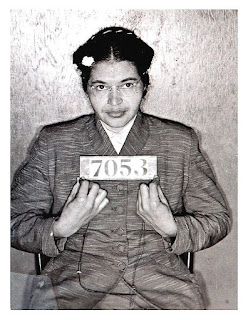According to a local historian in Montgomery, Alabama at this year’s Juneteenth Festival, a celebration that stemmed from the June 19th abolishment of slavery in Texas in 1865, Parks also was within her right to stay in her seat. According to Montgomery law at the time, if the bus was “standing room only” black people could keep their seats. As the bus began to fill up, the 10 seats at the front of the bus already filled with white passengers forced the bus driver to move the marker separating the white and black seats back a row, thus putting Ms. Parks in a “white seat.” When a white passenger came onto the bus and demanded that row of seats, three black riders moved the back: Ms. Parks did not. She politely moved the window seat. After threats, the driver was summoned and when he threatened to call the police if she didn’t move.
Rosa Parks said in quiet defiance, “You may do that.”
What happened in the days after this historic event is a glowing example of teamwork and the components of it. Here was a young “soldier” in Ms. Parks who through her actions found a rallying point. Once arrested, the black community of Montgomery began to force the action.
What happened was called the Montgomery Bus Boycott. Three days after Parks’ arrest, black churches began to spread the idea of a bus boycott and on December 5th, when Ms. Parks was found guilty in 30 minutes of disorderly conduct and violating a city ordinance, a fine of $14 was levied but Parks appealed and challenged the idea of segregation.
On the day of her trial, 35,000 leaflets were distributed around the city and a young minister was put in charge of the boycott, Martin Luther King Jr. This coach would mastermind a boycott of city buses that crippled the financial structure of the city of Montgomery.
What happened in the days after this historic event is a glowing example of teamwork and the components of it. Here was a young “soldier” in Ms. Parks who through her actions found a rallying point. Once arrested, the black community of Montgomery began to force the action.
What happened was called the Montgomery Bus Boycott. Three days after Parks’ arrest, black churches began to spread the idea of a bus boycott and on December 5th, when Ms. Parks was found guilty in 30 minutes of disorderly conduct and violating a city ordinance, a fine of $14 was levied but Parks appealed and challenged the idea of segregation.
On the day of her trial, 35,000 leaflets were distributed around the city and a young minister was put in charge of the boycott, Martin Luther King Jr. This coach would mastermind a boycott of city buses that crippled the financial structure of the city of Montgomery.
When black passengers needed to get somewhere, local black residents with cars would take them. When there weren’t enough cars, King’s church bought a dozen more. When businessmen in Montgomery pressured the insurance companies of these drivers to drop them, local black leaders got insurance policies on their own and covered the drivers. There were no black riders on Montgomery buses for 381 days!
This kind of multi tiered teamwork is hard to imagine today. The idea that everyone is behind a common goal, this goal SO monumental in history, that it broke the back of corporate Montgomery and forced new legislation is an example of what CAN be done when there is 100% buy in. When the whole is greater than the parts. When a leader is able to rally and inspire his team and when a team can rally around a moment of intense or extreme hardship.
Rosa Parks, being a Civil Rights worker before her arrest, understood what she was doing and her bravery and grit have never been forgotten. Her museum in Montgomery is a busy tourist destination and rightly so.
When Dr. King was asked about Mrs. Parks, he was candidly quoted, "Actually, no one can understand the action of Mrs. Parks unless he realizes that eventually the cup of endurance runs over, and the human personality cries out, 'I can take it no longer.'”




No comments:
Post a Comment